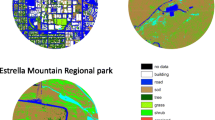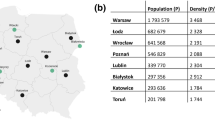Abstract
Numerous animals have successfully invaded urban habitats, although the factors associated with invasion success remain poorly understood. Urban areas are characterized by warmer microclimates, higher levels of primary productivity, longer breeding seasons and higher levels of pollutants. All these factors should cause oxidative stress, favoring invasion by species that have access to high levels of antioxidants. We analyzed concentrations of two categories of dietary, fat-soluble antioxidants (total carotenoids, total vitamin E) in the liver, the main storage organ in birds. Individuals killed by cats had lower levels of vitamin E than individuals that died for other reasons, showing natural selection on stored antioxidants. Bird species that had successfully colonized urban areas had significantly higher levels of vitamin E and total carotenoids than species that did not succeed, and rural populations had higher concentrations of vitamin E and total carotenoids than urban populations of the same species. Interspecific differences in concentrations of fat-soluble antioxidants, and differences between rural and urban populations of the same species, were accounted for by diet, but also by time since urbanization and number of generations since urbanization. These findings suggest that antioxidants, and by implication the ability to cope with oxidative stress, have contributed to successful invasion of urban areas by birds, and that the concentration of these antioxidants has changed in response to the urban environment.



Similar content being viewed by others
References
Batten LA (1973) Population dynamics of suburban blackbirds. Bird Study 20:251–258
Bendich A (1989) Carotenoids and the immune response. J Nutr 119:112–115
Biard C, Gil D, Karadas F, Saino N, Spottiswoode C, Surai PF, Møller AP (2009) Maternal effects mediated by antioxidants and the evolution of carotenoid-based signals in birds. Am Nat 174:696–708
Blumstein DT (2006) Developing an evolutionary ecology of fear: how life history and natural history traits affect disturbance tolerance in birds. Anim Behav 71:389–399
Bonier F, Martin PR, Wingfield JC (2007) Urban birds have broader environmental tolerance. Biol Lett 3:670–673
Brauner EV, Forchhammer L, Møller P, Simonsen J, Glasius M, Wahlin P, Raaschou-Nielsen O, Loft S (2007) Exposure to ultrafine particles from ambient air and oxidative stress-induced DNA damage. Environ Health Perspect 115:1177–1182
Brown JCL, McClelland GB, Faure PA, Klaiman JM, Staples JF (2009) Examining the mechanisms responsible for lower ROS release rates in liver mitochondria from the long-lived house sparrow (Passer domesticus) and big brown bat (Eptesicus fuscus) compared to the short-lived mouse (Mus musculus). Mech Age Dev 130:467–476
Burnham KP, Anderson DR (2001) Model selection and multi-model inference. Springer, New York
Chew BP (1993) Role of carotenoids in the immune response. J Dairy Sci 76:2804–2811
Cohen J (1988) Statistical power analysis for the behavioral sciences, 2nd edn. Erlbaum, Hillsdale
Costantini D, Møller AP (2008) Carotenoids are minor antioxidants for birds. Funct Ecol 22:367–370
Costantini D, Møller AP (2009) Does immune response cause oxidative stress in birds? A meta-analysis. Comp Biochem Physiol B 153:339–344
Cramp S, Perrins CM (eds) (1977–1994) The birds of the Western Palearctic. Vols 1–9. Oxford University Press, Oxford
de Ayala RM, Martinelli R, Saino N (2007) Vitamin E supplementation enhances growth and condition of nestling barn swallows (Hirundo rustica). Behav Ecol Sociobiol 60:619–630
Draper NR, Smith H (1981) Applied regression analysis, 2nd edn. Wiley, New York
Eeva T, Lehikoinen E, Ronka M (1998) Air pollution fades the plumage of the great tit. Funct Ecol 12:607–612
Evans KL, Gaston KJ, Sharp SP, McGowan A, Simeoni M, Hatchwell BJ (2009) Effects of urbanization on disease prevalence and age structure in blackbird Turdus merula populations. Oikos 118:774–782
Felsenstein J (1985) Phylogenies and the comparative method. Am Nat 125:1–15
Fløystrup A (1920) Fugleliv i Kjøbenhavn: Iagttagelser fra Østre Anlæg og Botanisk Have. Dansk Orn Foren Tidsskr 14:1–60
Fløystrup A (1925) Fugleliv i Kjøbenhavn: Fortsatte iagttagelser fra Østre Anlæg og Botanisk Have. Dansk Orn Foren Tidsskr 19:1–18
Garamszegi LZ, Møller AP (2009) Effects of sample size and intraspeciifc variation in phylogenetic comparative studies: a meta-analytic review. Biol Rev (in press)
Garland T Jr, Harvey PH, Ives AR (1992) Procedures for the analysis of comparative data using phylogenetically independent contrasts. Syst Biol 41:18–32
Gliwicz J, Goszczynski J, Luniak M (1994) Characteristic features of animal populations under synurbanization—the case of the blackbirds and the striped field mouse. Mem Zool 49:237–244
Glutz von Blotzheim UN, Bauer KM (eds) (1966–1997) Handbuch der Vögel Mitteleuropas. Aula, Wiesbaden
Gram C (1908) Fuglelivet i København og omegn for halvhundrede aar siden. Dansk Orn Foren Tidsskr 3:27–36
Hackett SJ, Kimball RT, Reddy S, Bowie RCK, Braun EL, Braun MJ, Chojnowski JL, Cox WA, Han K-L, Harshman J, Huddleton CJ, Marks BD, Miglia KJ, Moore WA, Sheldon FH, Steadman DW, Witt CC, Yuri T (2008) A phylogenomic study of birds reveals their evolutionary history. Science 320:1763–1768
Halliwell BH, Gutteridge JMC (2007) Free radicals in biology and medicine. Oxford University Press, Oxford
Hartley RC, Kennedy MW (2004) Are carotenoids a red herring in sexual display? Trends Ecol Evol 19:253–254
Hõrak P, Lebreton J-D (1998) Survival of adult great tits in relation to sex and habitat: a comparison of urban and rural populations. Ibis 140:205–209
Hõrak P, Ots I, Vellau H, Spottiswoode C, Møller AP (2001) Carotenoid-based plumage coloration reflects hemoparasite infection and local survival in breeding great tits. Oecologia 126:166–173
Hõrak P, Vellau H, Ots I, Møller AP (2002) Fat-soluble antioxidants in the eggs of great tits Parus major in relation to breeding habitat and laying sequence. Avian Science 2:123–130
Isaksson C, Örnborg J, Stephensen E, Andersson S (2005) Plasma glutathione and carotenoid coloration as potential biomarkers of environmental stress in great tits. Ecohealth 2:138–146
Isaksson C, McLaughlin P, Monaghan P, Andersson S (2007) Carotenoid pigmentation does not reflect total non-enzymatic antioxidant activity in plasma of adult and nestling great tits, Parus major. Funct Ecol 21:1123–1129
Isaksson C, Johansson A, Andersson S (2008) Egg yolk carotenoids in relation to habitat and reproductive investment in the great tit Parus major. Physiol Biochem Zool 81:112–118
Isaksson C, Sturve J, Almroth BC, Andersson S (2009) The impact of urban environment on oxidative damage (TBARS) and antioxidant systems in lungs and liver of great tits, Parus major. Environ Res 109:46–50
JMP (2000) JMP. SAS Institute, Cary
Jokimäki J, Suhonen J, Inki K, Jokinen S (1996) Biogeographical comparison of winter bird assemblages in urban environments in Finland. J Biogeogr 23:379–386
Jones KE, Purvis A (1997) An optimum body size for mammals? Comparative evidence from bats. Funct Ecol 11:751–756
Jønsson KA, Fjeldså J (2006) A phylogenetic supertree of oscine passerine birds (Aves: Passeri). Zool Scr 35:149–186
Kim HW, Chew BP, Wong TS, Park JS, Weng BBC, Byrne KM, Hayek MG, Reinhart GA (2000) Modulation of humoral and cell-mediated immune responses by dietary lutein in cats. Vet Immunol Immunopathol 73:331–341
Klausnitzer B (1989) Verstädterung von Tieren. Neue Brehm, Wittenberg Lutherstadt
Luniak M, Mulsow R (1988) Ecological parameters in urbanisation of the European blackbird. Acta Congr Int Orn 19:1787–1793
Møller AP (2008) Flight distance of urban birds, predation and selection for urban life. Behav Ecol Sociobiol 63:63–75
Møller AP (2009) Successful city dwellers: a comparative study of the ecological characteristics of urban birds in the Western Palearctic. Oecologia 159:849–858
Møller AP, Erritzøe J (2000) Predation against birds with low immunocompetence. Oecologia 122:500–504
Møller AP, Nielsen JT (2006) Prey vulnerability in relation to sexual coloration of prey. Behav Ecol Sociobiol 60:227–233
Møller AP, Biard C, Blount JD, Houston DC, Ninni P, Saino N, Surai PF (2000) Carotenoid-dependent signals: indicators of foraging efficiency, immunocompetence or detoxification ability? Poult Avian Biol Rev 11:137–159
Møller AP, Surai PF, Mousseau TA (2005) Antioxidants, radiation and mutation in barn swallows from Chernobyl. Proc R Soc Lond B 272:247–253
Møller AP, Karadas F, Mousseau TA (2008) Antioxidants in eggs of great tits Parus major from Chernobyl and hatching success. J Comp Physiol B 178:735–743
Neter J, Kutner MH, Nachtsheim CJ, Wasserman W (1996) Applied linear statistical models. Irwin, Chicago
Pérez-Rodríguez L, Mougeot F, Alonso-Alvarez C, Blas J, Viñuela J, Bortolotti G (2008) Cell-mediated immune activation rapidly decreases plasma carotenoids but does not affect oxidative stress in red-legged partridges (Alectoris rufa). J Exp Biol 211:2155–2161
Purvis A, Rambaut A (1995) Comparative analysis by independent contrasts (CAIC). Comp Appl Biosci 11:247–251
Saino N, Ferrari R, Romano M, Martinelli R, Møller AP (2003) Experimental manipulation of egg carotenoids affects immunity of barn swallow nestlings. Proc R Soc Lond B 279:2485–2489
Shochat E, Warren PC, Faeth SH, McIntyre NE (2006) From patterns to emerging processes in mechanistic urban ecology. Trends Ecol Evol 21:186–191
Sibley CG, Ahlquist JE (1990) Phylogeny and classification of birds, a study in molecular evolution. Yale University Press, New Haven
Sibley CG, Monroe BL Jr (1990) Distribution and taxonomy of birds of the world. Yale University Press, New Haven
Slagsvold T, Lifjeld JT (1985) Variation in plumage color of the great tit Parus major in relation to habitat, season and food. J Zool 206:321–328
Sokal RR, Rohlf FJ (1995) Biometry, 3rd edn. Freeman, New York
Stephan B (1999) Die Amsel. Neue Brehm, Wittenberg-Lutherstadt
Stradi R (1995) Il colore del volo. Solei, Milano
Surai PF (2002) Natural antioxidants in avian nutrition and reproduction. Nottingham University Press, Nottingham
Surai PF, MacPherson A, Speake BK, Sparks NHC (1999) Designer egg evaluation in a controlled trial. Eur J Clin Nutr 54:298–305
Acknowledgments
Several colleagues kindly provided specimens, and two reviewers provided constructive criticism.
Author information
Authors and Affiliations
Corresponding author
Additional information
Communicated by Markku Orell.
Electronic supplementary material
Below is the link to the electronic supplementary material.
Rights and permissions
About this article
Cite this article
Møller, A.P., Erritzøe, J. & Karadas, F. Levels of antioxidants in rural and urban birds and their consequences. Oecologia 163, 35–45 (2010). https://doi.org/10.1007/s00442-009-1525-4
Received:
Accepted:
Published:
Issue Date:
DOI: https://doi.org/10.1007/s00442-009-1525-4




